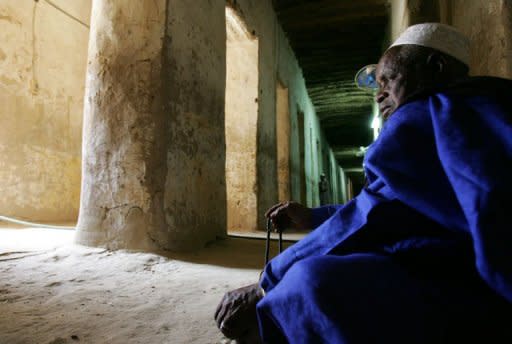Mali Islamists destroy tombs at ancient Timbuktu mosque
The Islamists controlling northern Mali on Tuesday destroyed two tombs at the ancient Djingareyber mosque in fabled Timbuktu, vowing to destroy all World Heritage sites in the region. Armed with hoes, pick-axes and chisels, members of Ansar Dine (Defenders of Faith) hammered away at the two earthen tombs until they were completely destroyed, witnesses told AFP. "Currently the Islamists are busy destroying two tombs of Timbuktu's great Djingareyber mosque. They are shooting in the air to chase away the crowd, to scare them," one witness said earlier as the rampage began. "The two mausolea are adjacent to the western wall of the great mosque and the Islamists have hoes, chisels, they are hitting the mausolea which are made out of packed earth," said a source close to the mosque's imam. "They say they will destroy everything." Another witness reported that the Islamists had cried "Allahu Akbar" (God Is Great) as they hammered away at the mosque, one of the most important in Timbuktu. He added that the Islamists had blocked off two main roads leading to the mosque, which was one of the fabled city's main tourist attractions before the region became a no-go area for Westerners. The same witness reported that the Islamists had asked a television crew from the Qatar-based news channel Al-Jazeera to film their actions. The fighters from Ansar Dine began their destruction of the city's cultural treasures on July 1, shortly after UNESCO placed them on a list of endangered World Heritage sites. Declaring the ancient Muslim shrines "haram", or forbidden in Islam, Ansar Dine set about destroying seven of Timbuktu's 16 mausolea of ancient Muslim saints. They also destroyed the sacred door of the 15th-century Sidi Yahya mosque. Along with Sidi Yahya, Djingareyber and the Sankore mosque bear witness to Timbuktu's golden age as an intellectual and spiritual capital which was crucial in the spread of Islam throughout Africa. According to the UNESCO website, the Djingareyber mosque -- the oldest of the three -- was built by the sultan Kankan Moussa after his return in 1325 from a pilgrimage to Mecca. It was this pilgrimage which formed the legend of Timbuktu, as Moussa had travelled via Cairo with 60,000 porters, each carrying three kilogrammes of pure gold which he said came from Timbuktu. This amount of gold caused the Egyptian currency to lose its value, according to UNESCO, and put Timbuktu on the map as a mysterious African city of gold. On Tuesday a source in Ansar Dine told AFP that "from now on, as soon as foreigners speak of Timbuktu" they would attack anything referred to as a World Heritage site. "There is no world heritage, it doesn't exist. The infidels must not get involved in our business," said a Tunisian jihadist who gave his name only as Ahmed and said he was part of Ansar Dine's "media committee." "We will destroy everything, even if the mausolea are inside the mosques, and afterwards we will destroy the mausolea in the region of Timbuktu," he said. More ancient tombs are situated in the towns of Araouane and Gassra-Cheick in the greater Timbuktu region. A March 22 coup in Mali eased the way for Tuareg separatist rebels to seize a vast area in the north that they consider their homeland. However, the previously unknown Ansar Dine group seized the upper hand while fighting on their flanks. Openly allied with the north African group Al-Qaeda in the Islamic Maghreb, they have since pushed the Tuareg rebels from all positions of power. The international community fears the desert region, which is larger than France, will become a new haven for terrorist activity, and the Islamists have threatened any country that joins a possible military intervention force in Mali. West African mediators have ordered Mali's embattled interim government to form a unity government by July 31 that will be better able to deal with the northern occupation.




